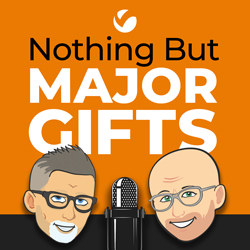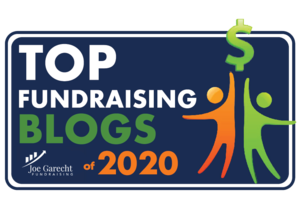
It’s gnawing at you. You know that there are a few donors on your caseload that, given the right relationship and an amazing offer, would have the ability to give a six- or seven-figure gift to your organization.
However, you may be ignoring them a bit because you are not sure what actions you need to take in order to solicit them for that kind of a gift.
I understand. This predicament happened to me early in my career. I worked as a development director for an institution that taught computer technology to people with disabilities and then placed them in great-paying jobs. So we had a good number of donors in the business world who had means.
I knew there were a couple of donors who had tremendous capacity, but I was so intimidated at the time that I chose to ignore them. Instead I went after the other major donors that gave $5k, $10k and $20k gifts. That seemed easier and more productive, because I didn’t have to spend a bunch of time to get to that level of gift.
Gosh, I was young.
Finally, I got a kick in the rear from the CEO. “Jeff, you really need to get out there and talk to these three different business people who have tremendous capacity. What are you waiting for?”
Exactly. What was I waiting for? I guess just trying get over my fear that they’d reject me. Looking back at that experience, I shake my head wondering: why was I so hesitant?
Well, I was naive and new to the career I guess – but I’m glad my CEO gave me that kick. Because it was just what I needed to start a process of learning that helps me counsel other MGOs today. I want to share what I learned and how to cultivate those large gifts from donors that I absolutely know are in your current caseload or database.
1. Believe you have these types of donors in your caseload. They are in there! You have at least 2-3 (perhaps more) donors who have the ability to make a transformational gift. The first step is to review your caseload and do some initial research on who has capacity. Once you have established capacity by looking at wealth indicator information, spoken to staff and board members about your donors, and done your own research, you need to pinpoint who they are.
2. Create a plan. Yes, let’s assume you already have a plan for every one of your caseload donors. But for these select few, you are going to do more extensive planning on four different levels.
- The first level of planning is research. Research is going to include a series of face-to-face meetings in order to understand the donor’s passions and interests. In addition, you are going to find out everything you possibly can about their philanthropy, their connections, and their relationship to your organization – and the history behind it.
- The second level of planning is around communication. Throughout the course of the year, you will be planning touches that are very specific to that donor. Anything related to his passions and interests, even if it’s outside your organization.
- The third level of planning is identifying within your organization the project or program that your donor will want to invest in. This means you know this project or program almost as well as the Director of Programs. It also means you are spending quite a bit of your time immersing yourself in the program.
- Finally, the fourth level of planning is around the actual solicitation. This may or may not all happen within 12 months, and your team will have to determine that based on where the donor is in the relationship. If you have done the right planning in 1-3, the fourth level will come very naturally. You will know the right time. But at this level of planning, you will also know the appropriate staff and materials for the solicitation, and you should make sure you put in enough hours practicing the face-to-face ask. This level of planning also includes knowing exactly the correct amount to solicit.
3. Stick with it. As you can already tell, soliciting a donor for a very large gift takes time, patience and a lot of hard work. It is very rare that some donor will ever come up to you with an open checkbook and hand over a million dollars. You have to stay with it. You have to continually deepen relationships, both with the donor and those in your organization who are helping you create the appropriate offer. You will get discouraged over time. You have to move through that discouragement and know that if you are doing all the right things, that is all you can do. Most of the time, good things will happen when you stick with it.
This is what I learned as a young development director. I had a lot of help, but I was able to secure a few six-figure gifts for our organization from donors that previously hadn’t ever given like that to us before. What was most satisfying in all of it was how much the donors appreciated the process, and how good they felt in giving those large gifts. It was a lot of work, but it was well worth that effort.
You have donors right now who, if inspired, would invest a great amount in your organization. So take this blog today as your little kick in the behind, and start identifying who they are. You can do it!
Jeff






Jeff – I always appreciate your insights. Here’s my struggle with a mega-donor in my case load: the board member with the closest relationship and greatest access to the donor does not believe in the process; he says the donor’s time is very limited, so he wants to set it up as a one shot meeting, no more than 30 minutes to present the offer and make the ask (with no actual dollar amount). I am certain we’ll end up with “go away money” with that approach but how do I convince the board member of the steps necessary to make this a true donor-centered engagement that inspires a transformational gift?
Andrea, thanks for writing. Is there any way for you to sit down with the board member and talk about best practices and how the board members approach really isn’t centered on the donor, but about getting a gift? Short-term you will probably get a gift, but you are right that it will be a “go away” gift rather than something the donor will truly feel fantastic about. Every donor’s time is limited. Slip this blog post in his coat pocket…:)
You might consider asking the board member to put him/herself in the donors shoes for a moment and without context be asked to support a program that you may not even resonate with. You are not going to get an investment type of gift. Sounds like the board member is embarrassed to involve this donor and feels very uncomfortable fundraising. That is the main issue. I would discuss that issue with the board member and see if he/she will engage with you on that level.
Let us know how it goes. This is a tough one.
Jeff